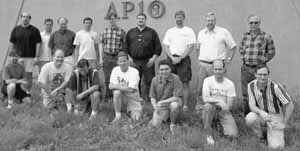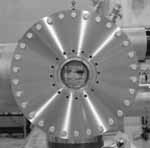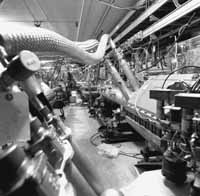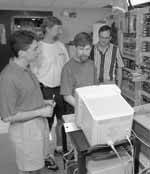 |
|
Antiproton Ugrade by Mike Perricone
Without antiprotons, the collider run would produce the sound of one hand clapping.
Antiprotons are pivotal in achieving what Fermilab Director Michael Witherell anticipates will be 100 times the integrated luminosity of Run I, the experimental run that yielded the discovery of the top quark in 1995. Complicating the process is a limit imposed by the Tevatron. The four-mile accelerator is near the capacity of protons it can hold without defocusing the counter-circulating antiproton beam and limiting its brightnessˇa phenomenon called beam-beam tune spread.
The Tevatron was in the midst of its transition from 400 GeV to 800 GeV, accomplished in 1984. And in October, 1985, the first proton-antiproton collisions were observed by the CDF detector (DZero had yet to be built) at 1.6 TeV center-of-mass energy; that is, 800-GeV protons circulating the Tevatron clockwise colliding with 800-GeV antiprotons circulating the Tevatron counter-clockwise. Within a decade, the lab announced first the evidence, and then the discovery, of the top quark.
Any similar discoveries at the Tevatron's detectors in the 21st centuryˇand hopefully in the first five years of the 21st century, before the Large Hadron Collider turns on at CERN in Switzerlandˇ will hinge on the planned threefold increase of antiproton flux produced by a 19-member department (13 of them on control room shifts) working closely for some three years.
Simply defined, flux is the number of antiprotons coming off the target per unit time.
"If we cut a cross-section of the beam pipe coming out of the Pbar Source," says Dave McGinnis, head of the Antiproton Source department, "and we count the number of pbars passing in a unit of time, we want to triple that number."
The Antiproton Source has three segments: the target station and lens, where the pbars are produced from proton-target collisions and transported to the next step; the Debuncher, and the Accumulator. The Debuncher takes the highly diffuse beam coming off the target, and turns it into a continuous ribbon of beam to provide a better fit for the next accelerator, the Accumulator. The Debuncher also pre-cools the beam, reducing the phase space by a factor of five. The Accumulator takes in multiple pulses from the Debuncher and stacks them, squeezing them together to produce a core beam with a density more than 10,000 times greater than a single beam pulse from the Debuncher.
The new Debuncher stochastic cooling system, is the biggest technological gamble of the upgrade. It has doubled the bandwidth of the old stochastic cooling system, going from a range of 2-4 giga-hertz to a range of 4-8 gigahertz. Cooling, McGinnis explains, is directly proportional to bandwidth.
"We want a very narrow resolution in time, so we can look at particle and see if it's in the right spot and in the correct phase space," he says. "Looking at something very quickly means looking over a very broad bandwidth in frequencies. A flashbulb, for example, is a pulse of white light, which contains all frequencies. One way to look at stochastic cooling is that a wider bandwidth produces finer resolution. So by doubling the bandwidth, you double the resolution."
Stochastic cooling incorporates a pickup antenna, sensing a particle's position; electronics to process and transmit the data; and a kicker antenna to reposition the traveling particle. The 80 million pbars entering the Debuncher per pulse might sound like a lot, but actually there are so few of them (the Tevatron, for example, will hold a trillion) that they are hard for the pickups antennae to hear: they can be drowned out by the noise, called thermal noise, of the atoms moving within the structure of the Debuncher itself.
The unique design of the new pickups will have them operating at higher frequencies and lower temperatures, and handling more power, than the pickups used in any other stochastic cooling system anywhere.
"We showed the system to some people from the Very Large Array of radioastronomy telescopes in New Mexico, the ones that were featured in the movie ŰContact,'" McGinnis says. "They're also looking for very weak signals from the stars. Every one of their antennas has an amplifier cooled with gaseous helium, at 10-15 Kelvin. But they can't cool their entire antenna, which is huge. Not only do we cool our amplifier, we cool the entire antenna."
The new stochastic cooling system uses an array of eight narrowband microwave antennas instead of a single, wideband antenna. The principle is similar to that of cellular telephones: each unit has its own frequency to rule out cross talk. High sensitivity can be built more easily into a narrow band antenna, and the large number of narrow-band channels is equivalent to one wide-band channel.
That meant changing the lattice of the Accumulator ˇthe way the beam is focused around the accelerator, as determined by the strength and position of the quadrupole magnets. The lattice change represented a major challenge, because the Accumulator is a storage machine: the beam remains there for hundreds of hours at a time. Commissioning the lattice changes lasted until July of 1999; work then proceeded in reverse direction of the beam's path, first the Accumulator cooling, and then the Debuncher.
Charmonium and Transition
The Accumulator uses 84 quadrupole magnets to focus the Pbar beam, and six special focusing magnets had to be replaced. These special focusing magnets are about five wide but just a foot long. They must produce a very strong magnetic field in a small linear space in the Antiproton Source tunnel, and with a wide cross-section because of the wide beam aperture.
The Accumulator also runs the E385 (Charmonium) fixed-target experiment, which produces a particle consisting of a charm quark and anticharm quark from collisions between a Pbar beam and a jet of hydrogen gas in the accumulator. That experiment also required decelerating the Pbar beam, and holding the lower-energy beam for an adequate lifetime.
The Accumulator was not originally designed for this kind of ramping, which also means crossing transition energy.
"You don't want to cross transition energy," McGinnis warns. "It's very unpleasant for the beam."
Transition energy is a sort of relativistic border that occurs in every accelerator. Below the transition energy, high-energy particles take less time to navigate the accelerator than low-energy particles, which is what our intuition would lead us to expect. But above the transition energy, high-energy particles take longer to move around the accel- erator than do low-energy particles, because they acquire mass and move toward the outside of the beam path. They can't travel any faster than light-speed, so covering a longer distance takes more time.
The right direction
Commissioning on the upgrades began in January, 1999. The first stacking of antiprotons took place on Dec. 22, 1999, and McGinnis remembers that on Christmas Day, the group was stacking at a rate equivalent to just 1/1,000 of the commissioning goal, which could have been discouraging.
"But we got beam going around the machine, and now we're at one-fourth of our goal," McGinnis says. "We can actually support a collider run now. This is a wonderful group of people, a small group where everybody wanted to go in the right direction, and that's what you have to have with commissioning. Everybody worked lots of hours and lots of shifts."
The group worked with so much mutual regard that one member, Jim Budlong, was included when the group photograph was taken for this article, even though he was on vacation at the time. His coworkers came up with a headshot of Budlong and stuck it into the "0" of the AP10 sign on the building when they posed for the shot.
Their work isn't finished. They face some puzzles in increasing the stacking rate, cutting the cycling time in half, and doubling the yield into the Debuncher.
"We know what we have to do on each of the problems, and there are no show-stoppers," McGinnis says.
Unlike the theater, a high-energy physics show-stopper halts the production for a big problem, not for a big ovation. No showstoppers will mean a big round of applause for the cast of the Antiproton Source upgrade.
|
| last modified 6/16/2000 email Fermilab |
FRLsDFx9eyfrPXgV
 Antiprotons hold the key to the Fermilab's hoped-for ovations from an eager worldwide high-energy physics audience, in greeting the experimental results of Collider Run II at the Tevatron beginning March 1, 2001.
Antiprotons hold the key to the Fermilab's hoped-for ovations from an eager worldwide high-energy physics audience, in greeting the experimental results of Collider Run II at the Tevatron beginning March 1, 2001.
 The most fundamental answer will come from the sourceˇthe Antiproton Source, gearing up to triple its antiproton production for Run II. The two machines sharing this triangular-shaped ring, the Debuncher and the Accumulator, are undergoing major upgrades as part of the labwide preparations to push back the frontiers of high-energy physics once again in the 21st century.
The most fundamental answer will come from the sourceˇthe Antiproton Source, gearing up to triple its antiproton production for Run II. The two machines sharing this triangular-shaped ring, the Debuncher and the Accumulator, are undergoing major upgrades as part of the labwide preparations to push back the frontiers of high-energy physics once again in the 21st century.

 The Debuncher does its job in a relatively small amount of timeˇ37 turns around the 500-meter ring. The beam is essentially being stored the rest of its stay in the Debuncher. Compressing the beam to make it fit the smaller aperture of the Accumulator is the job of the stochastic cooling system, which takes a snapshot of the beam at one point on the ring, and relays information to the other side, aligning the beam particle by particle.
The Debuncher does its job in a relatively small amount of timeˇ37 turns around the 500-meter ring. The beam is essentially being stored the rest of its stay in the Debuncher. Compressing the beam to make it fit the smaller aperture of the Accumulator is the job of the stochastic cooling system, which takes a snapshot of the beam at one point on the ring, and relays information to the other side, aligning the beam particle by particle.
 The bandwidth was also doubled in the Accumulator's stochastic cooling system (from 1-2 gigahertz up to 2-4 gigahertz), to handle the three-fold increase in flux handed to it from the target and the Debuncher, though the temperature remained at 77 Kelvin. But it squealed: the change produced positive feedback, like a microphone held too close to speaker.
The bandwidth was also doubled in the Accumulator's stochastic cooling system (from 1-2 gigahertz up to 2-4 gigahertz), to handle the three-fold increase in flux handed to it from the target and the Debuncher, though the temperature remained at 77 Kelvin. But it squealed: the change produced positive feedback, like a microphone held too close to speaker.
 "When decelerating the beam for E835, or reducing its energy, we avoided crossing the transition energy by moving that energy a step ahead of the beam energy all the way down the pipe," McGinnis explains. "We were able to use the modifications for our lattice upgrades to continuously adjust the lattice down the ramp, and we changed our transition energy by a large amount down the ramp. Steve Werkema proposed the idea, and Giulio Stancari designed the ramps. We learned a lot about the machine, and a lot about the beam. This was a really neat piece of accelerator physics."
"When decelerating the beam for E835, or reducing its energy, we avoided crossing the transition energy by moving that energy a step ahead of the beam energy all the way down the pipe," McGinnis explains. "We were able to use the modifications for our lattice upgrades to continuously adjust the lattice down the ramp, and we changed our transition energy by a large amount down the ramp. Steve Werkema proposed the idea, and Giulio Stancari designed the ramps. We learned a lot about the machine, and a lot about the beam. This was a really neat piece of accelerator physics."